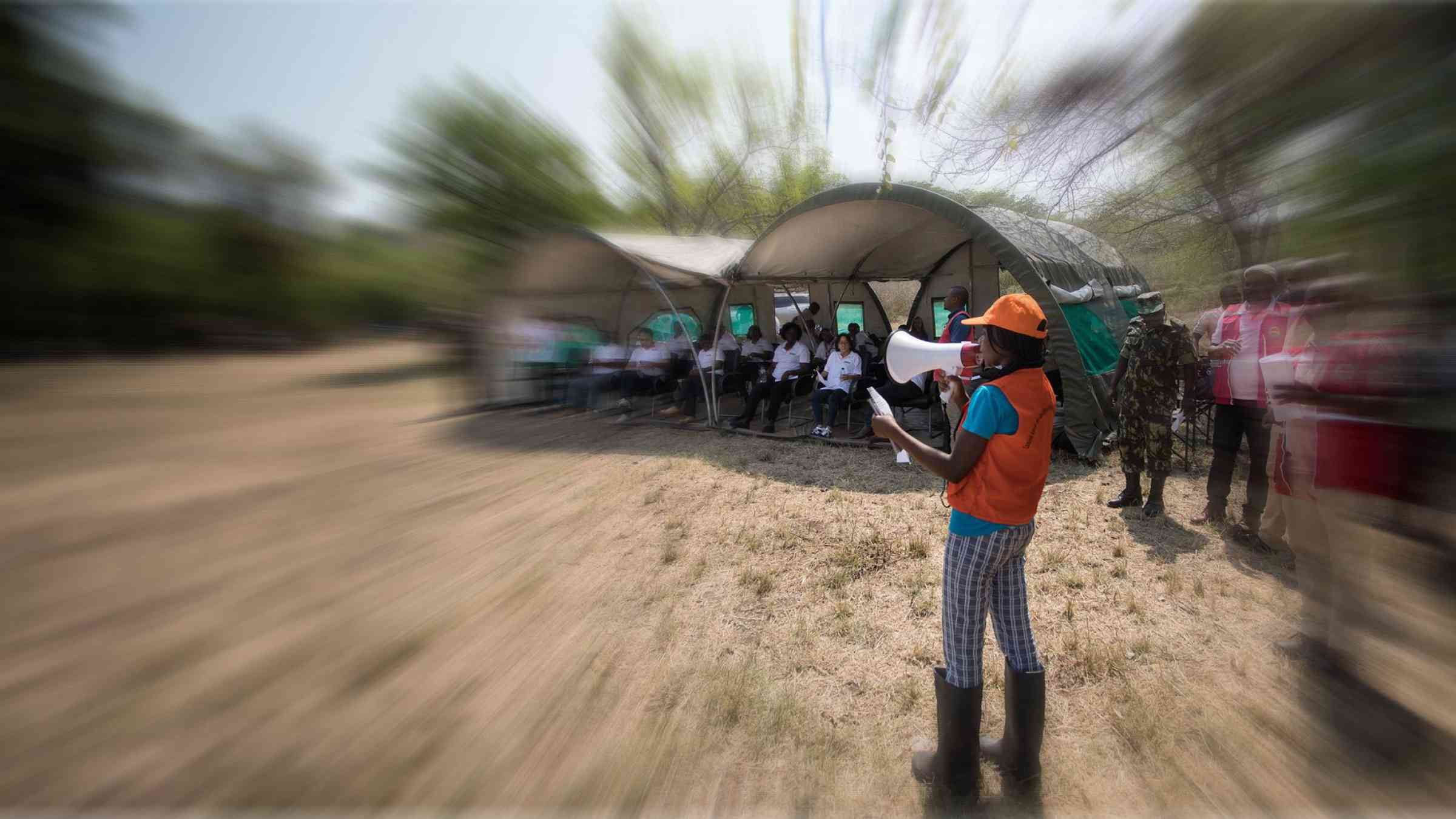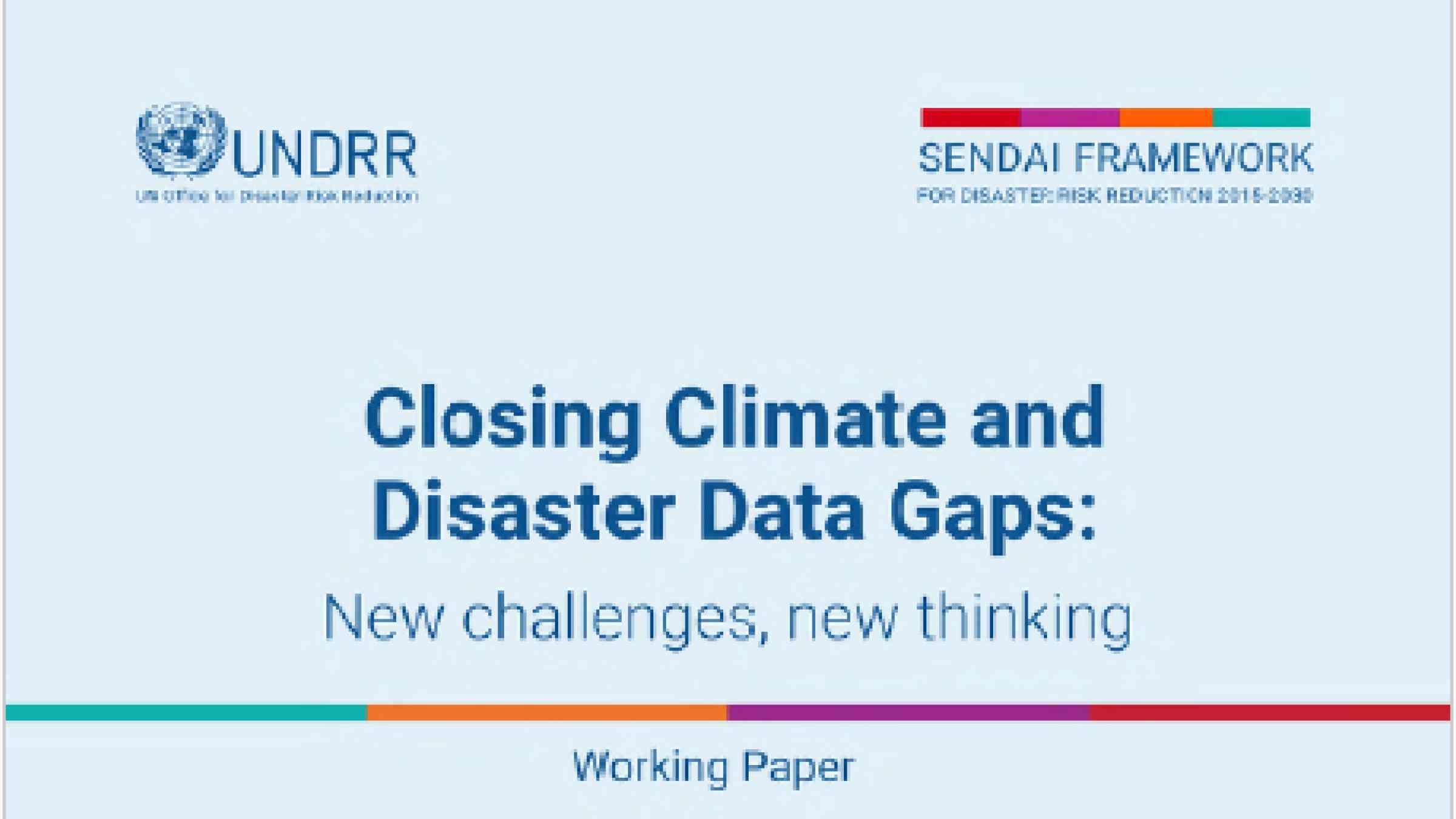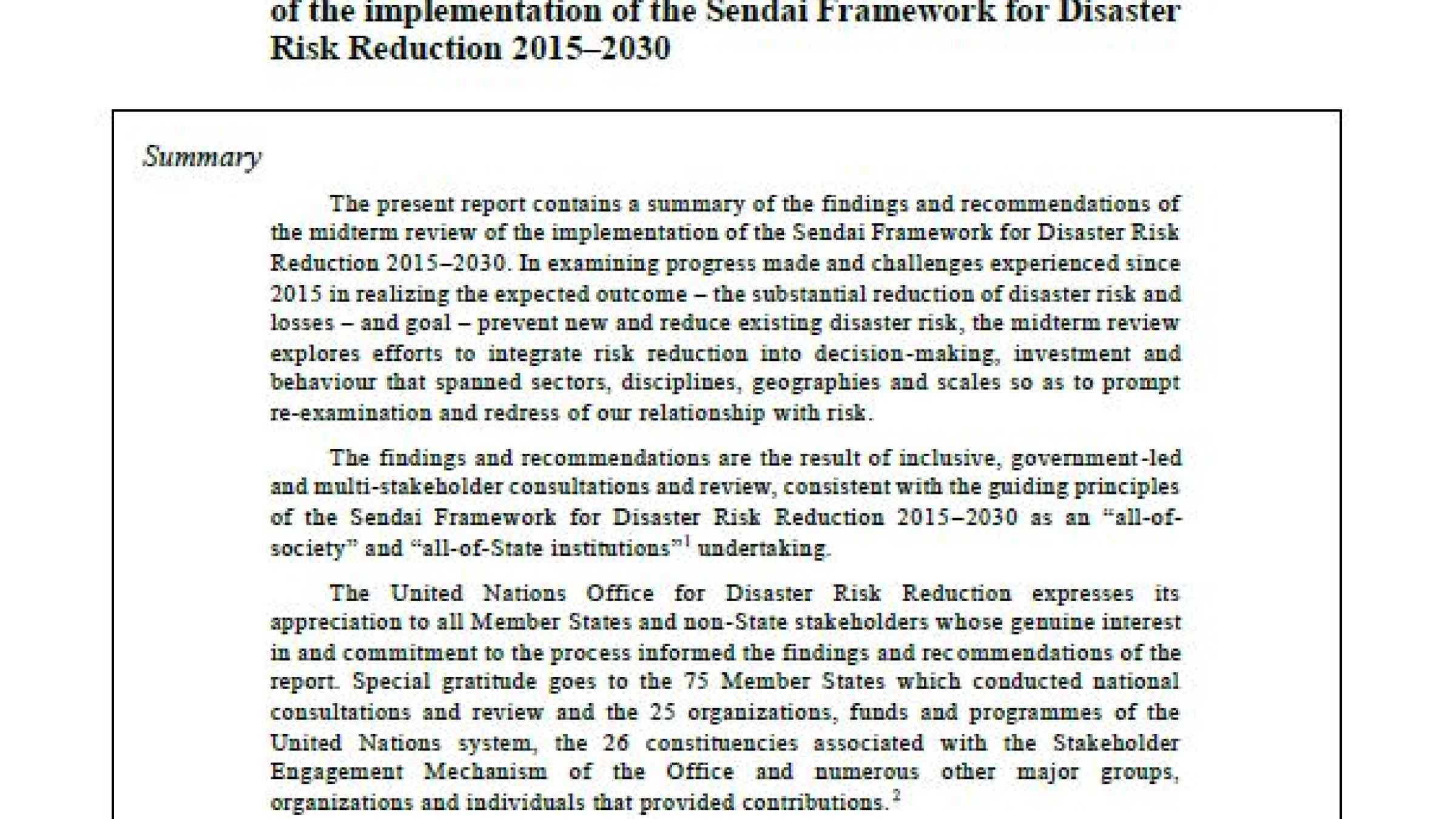A set of 38 indicators, recommended by an Open-ended Intergovernmental Expert Working Group, are used to track progress in implementing the seven targets of the Sendai Framework as well as its related dimensions reflected in the Sustainable Development Goals 1, 11 and 13. UN Member States report their progress through the Sendai Framework Monitor (SFM).
The online platform is also a tool to guide risk-informed policy decisions and to allocate resources accordingly towards reducing risk.
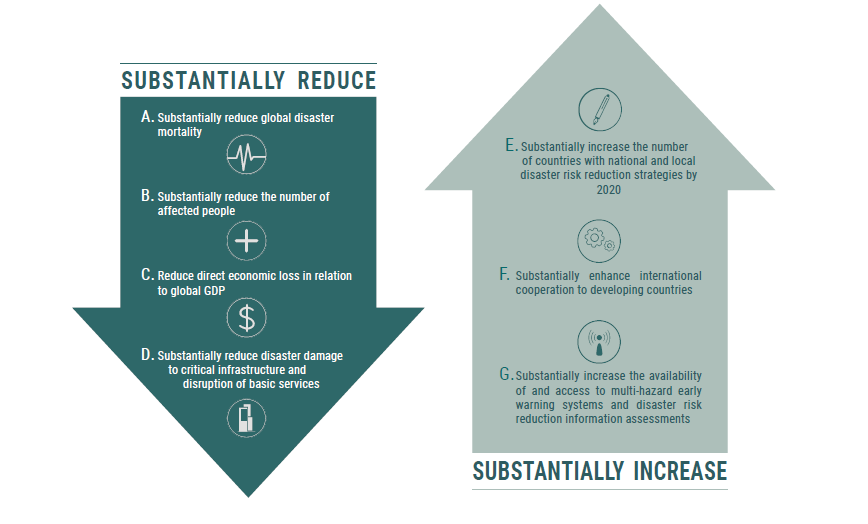
- Indicators
- Snapshot of SFM
- Integrated Monitoring with the SDGS
- Sendai Framework Monitor
- Disaster-related statistics
Indicators
Global target A: Substantially reduce global disaster mortality by 2030, aiming to lower average per 100,000 global mortality between 2020-2030 compared with 2005-2015.
| Target | Description |
|---|---|
| A-1 (compound) | Number of deaths and missing persons attributed to disasters, per 100,000 population. |
| A-2 | Number of deaths attributed to disasters, per 100,000 population. |
| A-3 | Number of missing persons attributed to disasters, per 100,000 population.The scope of disaster in this and subsequent targets is defined in paragraph 15 of the Sendai Framework for Disaster Risk Reduction 2015-2030 and applies to small-scale and large-scale, frequent and infrequent, sudden and slow-onset disasters caused by natural or man-made hazards, as well as related environmental, technological and biological hazards and risk. |
Global target B: Substantially reduce the number of affected people globally by 2030, aiming to lower the average global figure per 100,000 between 2020-2030 compared with 2005-2015.
| B-1 (compound) | Number of directly affected people attributed to disasters, per 100,000 population. |
|---|---|
| B-2 | Number of injured or ill people attributed to disasters, per 100,000 population. |
| B-3 | Number of people whose damaged dwellings were attributed to disasters. |
| B-4 | Number of people whose destroyed dwellings were attributed to disasters. |
| B-5 | Number of people whose livelihoods were disrupted or destroyed, attributed to disasters. |
Global target C: Reduce direct disaster economic loss in relation to global gross domestic product (GDP) by 2030.
| C-1 (compound) | Direct economic loss attributed to disasters in relation to global gross domestic product. |
|---|---|
| C-2 | Direct agricultural loss attributed to disasters. Agriculture is understood to include the crops, livestock, fisheries, apiculture, aquaculture and forest sectors as well as associated facilities and infrastructure. |
| C-3 | Direct economic loss to all other damaged or destroyed productive assets attributed to disasters. Productive assets would be disaggregated by economic sector, including services, according to standard international classifications. Countries would report against those economic sectors relevant to their economies. This would be described in the associated metadata. |
| C-4 | Direct economic loss in the housing sector attributed to disasters.Data would be disaggregated according to damaged and destroyed dwellings. |
| C-5 | Direct economic loss resulting from damaged or destroyed critical infrastructure attributed to disasters. The decision regarding those elements of critical infrastructure to be included in the calculation will be left to the Member States and described in the accompanying metadata. Protective infrastructure and green infrastructure should be included where relevant. |
| C-6 | Direct economic loss to cultural heritage damaged or destroyed attributed to disasters. |
Global target D: Substantially reduce disaster damage to critical infrastructure and disruption of basic services, among them health and educational facilities, including through developing their resilience by 2030
| D-1 (compound) | Damage to critical infrastructure attributed to disasters |
|---|---|
| D-2 | Number of destroyed or damaged health facilities attributed to disasters. |
| D-3 | Number of destroyed or damaged educational facilities attributed to disasters. |
| D-4 | Number of other destroyed or damaged critical infrastructure units and facilities attributed to disasters.The decision regarding those elements of critical infrastructure to be included in the calculation will be left to the Member States and described in the accompanying metadata. Protective infrastructure and green infrastructure should be included where relevant. |
| D-5 (compound) | Number of disruptions to basic services attributed to disasters. |
| D-6 | Number of disruptions to educational services attributed to disasters. |
| D-7 | Number of disruptions to health services attributed to disasters. |
| D-8 | Number of disruptions to other basic services attributed to disasters.The decision regarding those elements of basic services to be included in the calculation will be left to the Member States and described in the accompanying metadata. |
Global target E: Substantially increase the number of countries with national and local disaster risk reduction strategies by 2020.
| E-1 | Number of countries that adopt and implement national disaster risk reduction strategies in line with the Sendai Framework for Disaster Risk Reduction 2015-2030. |
| E-2 | Percentage of local governments that adopt and implement local disaster risk reduction strategies in line with national strategies.Information should be provided on the appropriate levels of government below the national level with responsibility for disaster risk reduction. |
Global target F: Substantially enhance international cooperation to developing countries through adequate and sustainable support to complement their national actions for implementation of this framework by 2030.
| F-1 | Total official international support, (official development assistance (ODA) plus other official flows), for national disaster risk reduction actions.Reporting of the provision or receipt of international cooperation for disaster risk reduction shall be done in accordance with the modalities applied in respective countries. Recipient countries are encouraged to provide information on the estimated amount of national disaster risk reduction expenditure. |
| F-2 | Total official international support (ODA plus other official flows) for national disaster risk reduction actions provided by multilateral agencies. |
| F-3 | Total official international support (ODA plus other official flows) for national disaster risk reduction actions provided bilaterally. |
| F-4 | Total official international support (ODA plus other official flows) for the transfer and exchange of disaster risk reduction-related technology. |
| F-5 | Number of international, regional and bilateral programmes and initiatives for the transfer and exchange of science, technology and innovation in disaster risk reduction for developing countries. |
| F-6 | Total official international support (ODA plus other official flows) for disaster risk reduction capacity-building. |
| F-7 | Number of international, regional and bilateral programmes and initiatives for disaster risk reduction-related capacity-building in developing countries. |
| F-8 | Number of developing countries supported by international, regional and bilateral initiatives to strengthen their disaster risk reduction-related statistical capacity. |
Global target G: Substantially increase the availability of and access to multi‑hazard early warning systems and disaster risk information and assessments to the people by 2030.
| G-1 (compound G2-G5) | Number of countries that have multi-hazard early warning systems. |
|---|---|
| G-2 | Number of countries that have multi-hazard monitoring and forecasting systems. |
| G-3 | Number of people per 100,000 that are covered by early warning information through local governments or through national dissemination mechanisms. |
| G-4 | Percentage of local governments having a plan to act on early warnings. |
| G-5 | Number of countries that have accessible, understandable, usable and relevant disaster risk information and assessment available to the people at the national and local levels. |
| G-6 | Percentage of population exposed to or at risk from disasters protected through pre-emptive evacuation following early warning.Member States in a position to do so are encouraged to provide information on the number of evacuated people. |
Snapshot of SFM
Integrated Monitoring with the SDGS
Both the Sendai Framework and the Sustainable Development Goals (SDGs) outcomes are a product of interconnected social and economic processes. As such, there is a lot of synergy between the two policy instruments. In fact, Sendai Framework monitoring is intended to complement monitoring of 11 SDG indicators listed below.
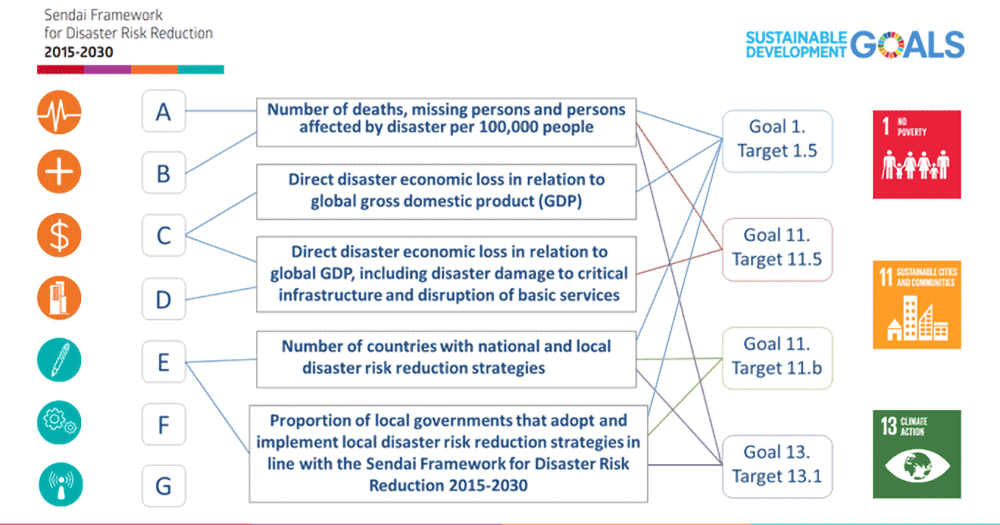
Goal 1. End poverty in all its forms everywhere
- Number of deaths, missing persons and directly affected persons attributed to disasters per 100,000 population
- SDG Indicator: 1.5.1
- Sendai Framework Indicators: A1 and B1
- Direct economic loss attributed to disasters in relation to global gross domestic product (GDP)
- SDG Indicator: 1.5.2
- Sendai Framework Indicators: C1
- Number of countries that adopt and implement national disaster risk reduction strategies in line with the Sendai Framework for Disaster Risk Reduction 2015-2030
- SDG Indicator: 1.5.3
- Sendai Framework Indicators: E1
- Proportion of local governments that adopt and implement local disaster risk reduction strategies in line with national disaster risk reduction strategies
- SDG Indicator: 1.5.4
- Sendai Framework Indicators: E2
Goal 11. Make cities and human settlements inclusive, safe, resilient and sustainable
- Number of deaths, missing persons and directly affected persons attributed to disasters per 100,000 population
- SDG Indicator: 11.5.1
- Sendai Framework Indicators: A1 and B1
- Direct economic loss attributed to disasters in relation to global gross domestic product (GDP)
- SDG Indicator: 11.5.2
- Sendai Framework Indicators: C1
- (a) Damage to critical infrastructure and (b) number of disruptions to basic services, attributed to disasters
- SDG Indicator: 11.5.3
- Sendai Framework Indicators: D1 and D5
- Number of countries that adopt and implement national disaster risk reduction strategies in line with the Sendai Framework for Disaster Risk Reduction 2015-2030
- SDG Indicator: 11.b.1
- Sendai Framework Indicators: E1
- Proportion of local governments that adopt and implement local disaster risk reduction strategies in line with national disaster risk reduction strategies
- SDG Indicator: 11.b.2
- Sendai Framework Indicators: E2
Goal 13. Take urgent action to combat climate change and its impacts
- Number of deaths, missing persons and directly affected persons attributed to disasters per 100,000 population
- SDG Indicator: 13.1.1
- Sendai Framework Indicators: A1 and B1
- Number of countries that adopt and implement national disaster risk reduction strategies in line with the Sendai Framework for Disaster Risk Reduction 2015-2030
- SDG Indicator: 13.1.2
- Sendai Framework Indicators: E1
- Proportion of local governments that adopt and implement local disaster risk reduction strategies in line with national disaster risk reduction strategies
- SDG Indicator: 13.1.3
- Sendai Framework Indicators: E2
Sendai Framework Monitor
The Sendai Framework Monitor was designed in close consultation with a broad base of stakeholders, and it was released as three modules in 2018.
- The first module allows for data entry related to the Sendai Framework global targets and indicators, agreed by all United Nations Member States.
- The second module allows for data entry related to custom targets and indicators. This gives Member States the opportunity to develop their own nationally determined custom targets and indicators to support the monitoring of their National Strategies for Disaster Risk Reduction and produce national reports as required, thus demonstrating their progress in implementing the Sendai Framework.
- The third module is an analytics module, which allows all validated information to be filtered for comparison by target, indicator, year and/or region and accessed as charts, maps and tables. This third module is publicly available and enables Member States to demonstrate their progress in contributing to the global targets and indicators of the Sendai Framework. It also shows how countries stand in their efforts on risk reduction as compared across time (e.g. with the period of the Hyogo Framework for Action 2005-2015) and space (across countries and regions).
Disaster-related statistics
A core foundation of risk-informed sustainable development is an evidence-based approach to policy and investment decisions to reach the most vulnerable. Policy makers mostly rely on official statistics, compiled and analysed with empirical rigour in all areas of governance, including disaster risk reduction.
Without this statistical interface, comparison across space and time, and inter-operability between data platforms will remain a challenge. Hence a universally accepted global framework for disaster-related statistics is urgently required, based on Fundamental Principles of Official Statistics, and building on the comprehensive initiatives that have been undertaken at the regional level.
The Open-ended Intergovernmental Expert Working Group on indicators and terminology related to disaster risk reduction recommended developing standards for disaster-related data and statistics including with engagement of national disaster risk reduction offices and national statistical offices. The OIEWG report was endorsed by the UN General Assembly (A/71/276) in 2017.
The UN Statistical Commission, at its 49th Session in 2018 welcomed a greater focus on disaster-related statistics (Decision 49/113). Subsequently, the Commission, at its 50th Session in 2019, requesting UNSD, UNESCAP, UNECE, UNECLAC and UNDRR (Decision 50/116) to establish a mechanism to develop a common framework on disaster-related statistics. An inter-agency and expert group (IAEG) on disaster-related statistics was established, terms of reference of which was approved by the Bureau of the UN Statistical Commission in 2020.
The IAEG is governed by a core group, consisting of the five regional commissions, UNSD and UNDRR. The IAEG is currently co-chaired by UNDRR and ESCAP. UNDRR also serves as the secretariat for IAEG.
Progress in advancing a common statistical framework
Towards developing a Common Statistical Framework for Disaster Risk Reduction, the IAEG-DRS has undertaken the following actions:
- Developed three issue papers on priority research topics,
- Economic losses attributed to disasters
- Disaster risk reduction expenditure satellite accounting; and
- Environmental and ecosystem-related disaster losses.
- Developed an annotated structure of a global common statistical framework for disaster-related statistics
- Conducted a review of existing guidance, including but not limited to the following:
- Disaster-related statistics framework published by ESCAP,
- Recommendations on the role of NSOs in disaster-related statistics published by ECE,
- Institutional and methodological recommendations for the measurement of indicators for the disaster-related Sustainable Development Goals and the Sendai Framework for Disaster Risk Reduction; and
- Hazard Definition and Classification Review and Hazard Information Profiles developed by UNDRR and the International Science Council.
The review provides recommendations on which elements should be included in the common framework while also identifying existing gaps. This has strengthened the research agenda and
helped develop issues related to guidelines and statistical standards for the respective topics under consideration.
Strengthening networks of expert communities
In order to promote a network of experts on the area of disaster-related statistics, a global expert forum bringing together practitioners from the statistics and disaster risk reduction communities have been organized in rotation by the UN Regional Commissions since 2021 on an annual basis as follows.
- UNECE hosted the first global Expert Forum for Producers and Users of Disaster-related Statistics in June 2021
- UNECWA organized the second Expert Forum in Sep 2022.
- The third Expert Forum is being hosted by UNESCAP in Bangkok in June 2023.
In addition to this, two annual meetings of the IAEG on Disaster-related Statistics were organized in May 2021 and Sep 2022. Side Events were also organized at the 52nd, 53rd and 54th sessions of UN Statistical Commission in 2021, 2022 and 2023 respectively.
Resources
- Global Common Statistical Framework for Disaster-related Statistics-Annotated outline (Working Paper)
- Measuring disaster-related economic losses (Working paper)
- Disaster Risk Reduction Expenditure Satellite Account (Working paper)
- Environmental and ecosystem-related disaster losses (Working paper)

